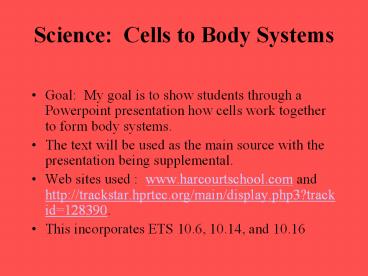Science: Cells to Body Systems - PowerPoint PPT Presentation
Title:
Science: Cells to Body Systems
Description:
Science: Cells to Body Systems Goal: My goal is to show students through a Powerpoint presentation how cells work together to form body systems. – PowerPoint PPT presentation
Number of Views:231
Avg rating:3.0/5.0
Title: Science: Cells to Body Systems
1
Science Cells to Body Systems
- Goal My goal is to show students through a
Powerpoint presentation how cells work together
to form body systems. - The text will be used as the main source with the
presentation being supplemental. - Web sites used www.harcourtschool.com and
http//trackstar.hprtec.org/main/display.php3?trac
kid128390. - This incorporates ETS 10.6, 10.14, and 10.16
2
Cells
- Simple organisms such as bacteria, are single
cell. - Plants and animals are made up of many cells.
- Each kind of cell has a particular function.
3
Cells Size Shape
- Size and Shape depend upon its function.
- Red blood cells are small and disc shaped to fit
through the smallest blood vessel. - Muscle cells are long and thin. When they
contract they produce movement. - Nerve cells which carry signals to the brain are
very long.
4
Functions of Cells
5
Plant /Animal Cell Definitions
Nucleus The organelle that determines all of a plants cell activities and prduces new cells. Cytoplasm A jellylike substance that contains many chemicals to keep the cell functiong. Nucleus The organelle that determines all of the animal cells activities and produces new cells. Vacuoles Organelles that store food, waste, or water.
Chromosones Threadlike structures that contain information about plant. Chloroplasts Organelles that make food for the plant cell. Chromosones Threadlike structures that contain information about the animal. Mitochondria Organelles that release energy from food.
Cell Membrane A covering that hold the plant cell together and separates it from surroundings. Vacuole An organelle that stores food, water, and waste. Cell Membrane a covering that holds the animal cell together and separates it from its surroundings.
Cell Wall A rigid layer that supports and protects plant cells. Mitochondria Organelles that release energy from food. Cytoplasm a jellylike substance that contains many chemicals to keep the cell functioning.
6
Tissues, Organs, Systems
- Cells that work together to perform a specific
function form a tissue. - Just as cells that work together form a tissue,
tissues that work together form an organ. - Organs that work together to perform a function
form a system. Example circulatory system. - Plant cells also form tissues, such as the bark
of a tree. And plant cells work together, forming
organs, such as roots and leaves.
7
The Circulatory System
8
The Respiratory System
- Air enters the body through nasal passages is
filtered, then travels down the trachea. - The trachea branches into two tubes called
bronchi, which lead to the lungs. - At the end of the bronchi are tiny tubes called
aveoli, small air sacs. - Carbon dioxide and oxygen are exchanged in the
aveoli and the oxygen rich blood enters the body
through the pulmonary veins.
9
The Digestive System
- Digestion begins as you chew food.
- Glands in your mouth produce saliva to moisten
food. - The food passes through the esophagus to the
stomach and moves to the small intestine. - Nutrients diffuse through the villi, tiny
projections from the intestine, into the blood.
10
The Excretory System
- The function of the excretory system is to remove
wastes from the body. - Cell wastes include carbon dioxide and ammonia.
- The kidneys, ureters, bladder, and urethra make
up the excretory system. - The body also removes wastes through sweating.
Sweat is a salty liquid that evaporates from the
skin.
11
Systems Working Together
12
The Muscular System
- Voluntary Muscles move bones and hold your
skeleton upright. - Smooth Muscles contract slowly and move
substances through the organs they surround. - Cardiac Muscles make up the walls of the heart.
Their function is to pump blood.
13
The Nervous System
- The nervous system connects all the tissues and
organs to your brain. - It consists of two parts The central nervous
system and peripheral nervous system. - The central nervous system consists of brain and
spinal cord. - The peripheral nervous system consists of sensory
organs, such as eyes, ears and body nerves.
14
Assignments
- Read Chapter 1, Unit A of Harcourt Science
Textbook and complete tasks related to the
reading. - Go to www.harcourtschool.com and complete the
activities relating to cell biology. - Go to http//trackstar.hprtec.org/main/display.php
3?trackid128390 and complete activities relating
to cell biology.
15
Assessment































